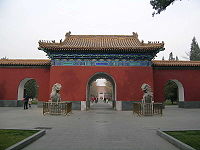
Zhongshan Park (Beijing)
Encyclopedia

Forbidden City
The Forbidden City was the Chinese imperial palace from the Ming Dynasty to the end of the Qing Dynasty. It is located in the middle of Beijing, China, and now houses the Palace Museum...
in the Dongcheng District
Dongcheng District, Beijing
Dongcheng District is an urban district in Beijing covering the eastern half of Beijing's urban core. It is 24.7 square kilometres in area and has a population of 535,558 . Dongcheng District covers several important parts of Beijing...
of central Beijing
Beijing
Beijing , also known as Peking , is the capital of the People's Republic of China and one of the most populous cities in the world, with a population of 19,612,368 as of 2010. The city is the country's political, cultural, and educational center, and home to the headquarters for most of China's...
.
Of all the gardens and parks surrounding the Forbidden City, such as the Beihai
Beihai Park
Beihai Park is an imperial garden to the northwest of the Forbidden City in Beijing. First built in the 10th century, it is amongst the largest of Chinese gardens, and contains numerous historically important structures, palaces and temples. Since 1925, the place has been open to the public as a...
and Jingshan
Jingshan Park
Jingshan is an artificial hill in Beijing, China. Covering an area of more than 230,000 m², Jingshan is immediately north of the Forbidden City on the central axis of Beijing. As a result, it is administratively part of both the Xicheng District and the Dongcheng District...
, Zhongshan is arguably the most centrally located of them all. The Zhongshan Park houses numerous pavilions, gardens, and imperial temples such as the Altar of Earth and Harvests
Beijing Shejitan
The Beijing Shejitan , also known as the Altar of Earth and Harvests or Altar of Land and Grain is a Confucian altar, located in the Zhongshan Park in Beijing. Built in 1421, it was used to perform the national soil and grain ceremonies. The Shejitan is also located in the opposite geometric...
or Altar of Land and Grain in some translations (Shejitan, 社稷坛), which was built in 1421 by the Yongle Emperor
Yongle Emperor
The Yongle Emperor , born Zhu Di , was the third emperor of the Ming Dynasty of China from 1402 to 1424. His Chinese era name Yongle means "Perpetual Happiness".He was the Prince of Yan , possessing a heavy military base in Beiping...
, and it symmetrically opposite the Imperial Ancestral Temple, and is where the emperors of Ming and Qing dynasties made offerings to the gods of earth and agriculture. The altar consists of a square terrace in the centre of the park.
By 1914, the altar grounds had become a public park known as the "Central Park". That park was then further renamed in 1928 after Sun Yat-Sen
Sun Yat-sen
Sun Yat-sen was a Chinese doctor, revolutionary and political leader. As the foremost pioneer of Nationalist China, Sun is frequently referred to as the "Father of the Nation" , a view agreed upon by both the People's Republic of China and the Republic of China...
(Zhongshan Park), in memory of China's first revolutionary political leader who helped bring about the first republic era in 1911, which is what the park is known as today. Many parks in China during that period also took on this name (see Zhongshan Park
Zhongshan Park
Zhongshan Park is a common name of Chinese parks, in honour of Sun Yat-sen, better-known in Chinese as Sun Zhongshan, who is considered by many to be the "Father of modern China"...
).
The Zhongshan Park includes various halls and pavilions built for the members of the imperial family, stone archways and a greenhouse which houses fresh flowers on display all year round. The greenhouse includes 39 varieties of tulips presented to the park in 1977 by the Princess of Holland.

